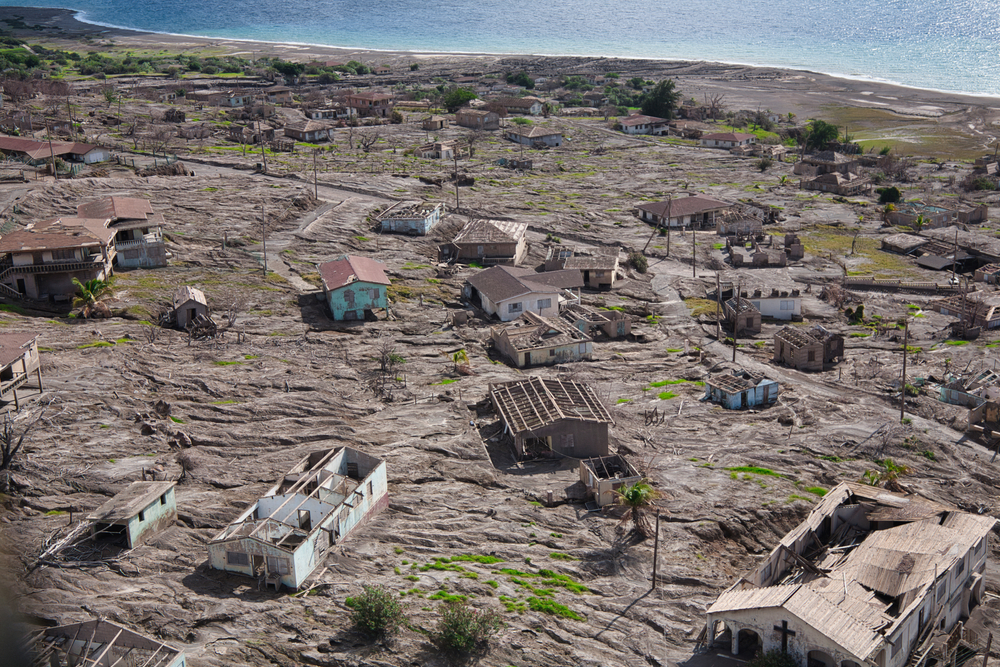The forces of nature that shape our planet are extraordinary. Nowhere in the Caribbean is this truer than the events which impacted AIR Montserrat. This iconic recording studio, now a ruin, is located on the island of Montserrat close to Antigua. George Martin, a record producer nicknamed the Fifth Beatle, already owned a successful recording studio in London. But the lure of the Caribbean was strong, and in 1977, when Martin visited the island, he was hooked on its beauty. Two years later, in July 1979 he opened a recording studio there.
Musicians quickly realised it would offer everything the London studio did, but in a more exotic location. The first client was Climax Blues Band, who came to work on Real to Reel, closely followed by Jimmy Buffett. He recorded an album called Volcano, a reference to the island’s Soufrière Hills volcano which had been dormant since the 16th century.
An iconic location for fans of Eighties’ music
Many of the most popular bands of the 1980s were soon queuing up to record there. Among them were the Police, who laid down first Ghost in the Machine and then Synchronicity. As Sting belted out “Every Little Thing She Does Is Magic” he could have been singing about Montserrat herself. The band shot the video right there in the studio.
Pop giants Duran Duran came too. They wrote and recorded some of their bestselling third album Seven and the Ragged Tiger in Montserrat. It was also the place where Paul McCartney and Stevie Wonder worked on Ebony and Ivory together, Dire Straits recorded Brothers in Arms there and Elton John knocked out three studio albums in the space of a decade. Other famous artists who took advantage of the facilities included Ultravox, Lou Reed, Eric Clapton, Luther Vandross, Marvin Gaye, Black Sabbath and Rush.
And then Hugo came along…
In 1989, when the Rolling Stones left the island having recorded Steel Wheels, no one could have imagined the events that were to follow. But the natural disaster that knocked AIR studio out of action wasn’t the volcano, it was a hurricane. Just a few short weeks after the release of Steel Wheels in August 1989, Hugo barrelled through. For much of the 20th century, Montserrat had been spared during hurricane season. The last major storm to do any significant damage had blown through way back in 1928.
Sadly, Hugo would make a direct hit. The eye wall moved across Montserrat on September 17th 1989 bringing with it sustained winds of 140 miles per hour. For 14 long hours the island was battered. Heavy rain and powerful winds wreaked havoc. An estimated 11000 out of the 12000 population lost their homes or were forced to flee because of structural damage. Ten people lost their lives and countless others suffered injuries. Hugo left the island with a repair bill running to around $260 million and destroyed something like 90% of Montserrat’s buildings.
Among them was AIR studio. Understandably, George Martin couldn’t face rebuilding. He acknowledged that things had changed and the industry wanted their artists closer to home where they could keep a closer eye on what they were doing. And so, with a heavy heart, he closed the doors on this chapter of his life for good.
Soufrière Hills – a volcano awakens
Six years later came a cataclysmic event that would ensure AIR Montserrat would never reopen. The Soufrière Hills volcano reawakened in 1995 and the violent eruption that ensued would alter the landscape of Montserrat for good. Still recovering from the after effects of Hugo, the islanders were left devastated by this second natural disaster. Faced with pyroclastic flows, ash deposits and mudflows, the island’s charming capital, Plymouth, was evacuated. Its population took with them what they could. The rest was buried under more than 12 metres of ash and mud. The island’s airport experienced a similar fate and was abandoned.

Even today, the area to the south of the island remains an exclusion zone and there are few recognisable landmarks. Those who stayed made a new home in the north and that’s also where you’ll find the new airport, a reminder that life – and tourism – goes on. In between the two, on the edge of the exclusion zone, you’ll find the ruins of AIR studio. Sadly, beyond its rusting gates, it’s off limits to visitors as the site is too unsafe. The roofs leak, the walls are crumbling and nature is well on the way to reclaiming the site.
A visit to Monserrat is a must if you’re in Antigua
Despite this, Montserrat is a fascinating place to visit. Day trippers come from its beautiful neighbour Antigua. Those who deliver the Buried City tours share deeply personal, emotionally charged stories as they explain what it was like to live throug
